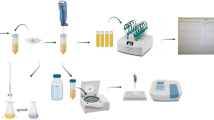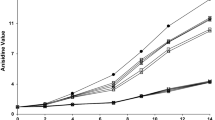Abstract
Heated oils may contain potentially toxic altered compounds. A denatured carob fiber, very rich in non-extractable tannins (Exxenterol®), exhibits antioxidant activities in in vitro experiments. The present study was designed to evaluate in sunflower oil (SO) heated to frying temperature, the protective effect on oil thermal oxidation and polymerization of adding 10 mg Exxenterol/kg oil (SO-10) and 50 mg Exxenterol/kg oil (SO-50). After 2, 8 and 16 h at 180 °C, SO displayed a relevant increase in triacylglycerol-derived polar material (PM) and polymer contents and a decrease in α-tocopherol concentrations. Thermal oxidation changes were significantly checked in SO-50 throughout the 16-h heating, while SO-10 only displayed protection from thermal oxidation during the first 2 h of heating. Oil frying-life was doubled because formation of PM and polymers was inhibited by more than 50%. Results clearly show that this non-extractable tannin-rich fiber can be successfully employed as an additive to significantly prolong sunflower oil frying-life, and thus decrease the potential toxicity of the heated oil.






Similar content being viewed by others
References
López-Varela S, Sánchez-Muniz FJ, Cuesta C (1995) Decreased food efficiency ratio, growth retardation and changes in liver fatty acid composition in rats consuming thermally oxidized and polymerized sunflower oil used for frying. Food Chem Toxicol 33:181–189
Aruna K, Rukkumani R, Sureshvarma P, Menon VP (2004) Role of an aminothiazole derivative on ethanol- and thermally oxidized sunflower oil-induced toxicity. Pol J Pharmacol 56:233–240
Romero A, Bastida S, Sánchez-Muniz FJ (2006) Cyclic fatty acid monomer formation in domestic of frozen food in sunflower oil and high oleic acid sunflower oil without oil replenishment. Food Chem Toxicol 44:1674–1681
Hochgraf E, Mokady S, Cogan U (1997) Dietary oxidized linoleic acid modifies lipid composition of rat liver microsomes and increases their fluidity. J Nutr 127:681–686
Quiles JL, Huertas JR, Battino M, Ramírez-Tortosa MC, Cassinello M, Mataix J, Lopez-Frias M, Mañas M (2002) The intake of fried virgin olive or sunflower oils differentially induces oxidative stress in rat liver microsomes. Br J Nutr 88:57–65
Mataix J, Barbancho FJ (2006) Olive oil in Mediterranean food. In: Quiles JL, Ramírez-Tortosa MC, Yaqoob P (eds) Olive oil and health. CAB International, Oxfordshire, pp 1–44
Sánchez-Muniz FJ, Bastida S, Márquez-Ruiz G, Dobarganes D (2007) Effect of heating and frying on oil and food fatty acids. In: Chow CK(Ed) Fatty Acids in Foods and their Health Implications. CR Press, Boca Raton, pp 511–543
Garrido-Polonio MC, Sánchez-Muniz FJ, Arroyo R, Cuesta C (1994) Small scale frying of potatoes in sunflower oil: thermoxidative alteration of the fat content in the fried product. Z Ernahrungswiss 33:267–276
Dobarganes MC, Márquez-Ruiz G, Berdeaux O, Velasco J (1999) Determination of oxidation compounds and oligomers by chromatographic techniques. In: Boskou D, Elmadfa I (eds) Frying of food. oxidation, nutrient and non-nutrient antioxidants, biologically active compounds and high temperatures. Technomic Publishing Co Inc., Lancaster, pp 143–161
Sánchez-Muniz FJ (2006) Oils and fats: changes due to culinary and industrial processes. Int J Vitam Nutr Res 76:230–237
Dobarganes MC, Pérez-Camino MC (1988) Fatty acid composition: a useful tool for the determination of alteration level in heated fats. Rev Fr Corps Gras 35:67–70
Varela G, Ruiz Roso B (2000) Some nutritional aspects in olive oil. In: Harwood J, Aparicio R (eds) Handbook of olive oil, analysis and properties. Aspen Publisher Inc., Gaithersburg, pp 565–580
Sánchez-Muniz FJ, Bastida S (2006) Effect of frying and thermal oxidation on olive oil and food quality. In: Quiles JL, Ramírez-Tortosa MC, Yaqoob P (eds) Olive oil and health. CAB International, Oxfordsshire, pp 74–108
Carlson BL, Tabacchi MH (1986) Frying oil deterioration and vitamin loss during food service operation. J Food Sci 51:218–221
Gordon MH, Kourimska L (1995) Effect of antioxidants on losses of tocopherols during deep-fat frying. Food Chem 52:175–177
Andrikopoulos NK, Dedoussis GV, Falirea A, Kalogeropoulos N, Hatzinikola HS (2002) Deterioration of natural antioxidant species of vegetable edible oils during the domestic deep-frying and pan-frying of potatoes. Inter J Food Sci Nutr 53:351–363
Boskou D (1999) Non-nutrient antioxidants and stability of frying oils. In: Boskou D, Elmadfa I (eds) Frying of food. oxidation, nutrient and non-nutrient antioxidants, biologically active compounds and high temperatures. Technomic Publishing Co Inc., Lancaster, pp 183–204
Fine AM (2000) Oligomeric proanthocyanidin complexes: history, structure, and phytopharmaceutical applications. Altern Med Rev 5:144–151
Bagchi D, Krohn RL, Bagchi M, Tran MX, Stohs SJ (1997) Oxygen free radical scavenging abilities of vitamin C and E, and a grape seed proanthocyanidin extract in vitro. Res Comm Mol Pathol Pharmacol 95:179–189
Pérez-Olleros L, García-Cuevas M, Ruiz-Roso B, Requejo A (1999) Comparative study of natural carob fiber and psyllium husk in rats. Influence on some aspects of nutritional utilization and lipidaemia. J Sci Food Agric 79:173–178
Pérez-Olleros L, García Cuevas M, Ruiz-Roso B (1999) Influence of pulp and natural carob fibre on some aspects of nutritional utilization and cholesterolemia in rats. Food Sci Tech Inter 5:425–430
Vaquero MP, Pérez-Olleros L, García-Cuevas M, Veldhuizen M, Ruiz-Roso B, Requejo A (2000) Mineral absorption of diets containing natural carob fiber compared to cellulose, pectin and various combinations of these fibers. Food Sci Tech Inter 6:463–471
Zunft HJF, Lueder W, Harde A, Haber B, Graubaum HJ, Gruenwald J (2003) Carob pulp preparation rich in insoluble fibre lowers total and LDL cholesterol in hypercholesterolemic patients. Eur J Nutr 42:235–242
Ruiz-Roso B, Pérez-Olleros L, Requejo A (2003) El Exxenterol®, un extracto de fibra vegetal con un potente efecto reductor del colesterol. Schironia 2:5–9
Ruiz-Roso B, Requejo A, Haya J, Pérez-Olleros L (2008) Efectos del Exxenterol sobre los lípidos séricos de un grupo de sujetos hipercolesterolémicos. Schironia 7:21–25
Ruiz-Roso B, Pérez-Olleros L, Requejo A, Hueso JA (2007) Product of vegetal origin comprising proanthocyanidines and its preparation process. ES2245610 B1, US2008063733 A1
Dobarganes MC, Velasco J, Dieffenbacher A (2000) Determination of polar compounds polymerized and oxidized triacylglycerols, and diacylglycerols in oils and fats. Results of collaborative studies and the standardized method (Technical report). Pure Appl Chem 72:1563–1575
IUPAC (1992) Method 2.432. In: International union of pure and applied chemistry (ed) Standard methods for the analysis of oils, fats and derivatives. 1st supplement to the 7th edn, Pergamon Press, Oxford
Sánchez-Muniz FJ, Bastida S (2003) Frying oil discarding: polar content vs. oligomer content determination. Forum Nutr 56:345–347
Lumley ID (1998) Polar compounds in heated oils. In: Varela G, Bender AE, Morton ID (eds) Frying of food, principles, changes, new approaches. Ellis Horwood, Chichester, pp 166–173
Romero A, Bastida S, Sánchez-Muniz FJ (2007) Cyclic fatty acid monomer in sunflower oils during frying of frozen foods with oil replenishment. Eur J Lipid Sci Technol 109:165–173
Firestone D (1996) Regulation of frying fat and oil. In: Perkins EG, Erickson MD (eds) Deep frying. chemistry, nutrition, and practical applications. AOCS Press, Champaign, pp 323–324
DGF (German Society for Fat Research) (2000) In: Proceedings of the 3rd international symposium of deep-fat frying. Final recommendations. Eur J Lipid Sci Technol 102:594
Márquez-Ruiz G, Martín-Polvillo M, Dobarganes MC (1996) Quantitation of oxidized triglyceride monomers and dimers as a useful measurement for early and advanced stages of oxidation. Grasas y Aceites 47:48–53
Marmesat S, Velasco L, Ruiz-Méndez MV, Fernández-Martínez JM, Dobarganes C (2008) Thermostability of genetically modified sunflower oils differing in fatty acid and tocopherol compositions. Eur J Lipid Sci Technol 110:776–782
Wagner KH, Elmadfa I (1999) Nutrient antioxidants and stability of frying oils: tocochromanols, β-carotene, phylloquinone, ubiquinone 50. In: Boskou D, Elmadfa I (eds) Frying of food. oxidation, nutrient and non-nutrient antioxidants, biologically active compounds and high temperatures. Technomic, Lancaster, pp 163–182
Papagiannopoulos M, Wollseifen HR, Mellenthin A, Haber B, Galensa R (2004) Identification and quantification of polyphenols in carob fruits (Ceratonia siliqua L.) and derived products by HPLC–UV–ESI/MS. J Agric Food Chem 52:3784–3791
González-Muñoz MJ, Bastida S, Sánchez-Muniz FJ (1998) Short term in vivo digestibility of triacylglycerol polymers, dimmers and monomers of thermoxidized palm olein used in deep-frying. J Agric Food Chem 46:5158–5193
Sánchez-Muniz FJ, Bastida S, González-Muñoz MJ (1999) Column and high performance size exclusion chromatography application to the in vivo digestibility study of a thermoxidized and polymerized olive oil. Lipids 34:1187–1192
Acknowledgments
The authors acknowledge the Banco de Santander (Brasil) for the fellowship awarded to Daniele Zulim Botega. Financial support for this investigation was provided by the Spanish Ministerio de Educación y Ciencia Project AGL-2008-04892-C03-02, CSIC-EDOCUSA project, and Consolider-Ingenio 2010, reference CSD2007-00016.
Author information
Authors and Affiliations
Corresponding author
Additional information
Daniele Zulim Botega is a visiting scientist from de University of Campinas, Brasil.
About this article
Cite this article
Zulim Botega, D., Bastida, S., Marmesat, S. et al. Carob Fruit Polyphenols Reduce Tocopherol Loss, Triacylglycerol Polymerization and Oxidation in Heated Sunflower Oil. J Am Oil Chem Soc 86, 419–425 (2009). https://doi.org/10.1007/s11746-009-1368-5
Received:
Accepted:
Published:
Issue Date:
DOI: https://doi.org/10.1007/s11746-009-1368-5




